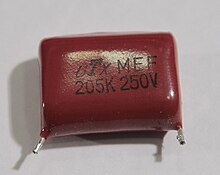Biaxially oriented polyester film
Biaxially oriented polyester film ( BO-PET , PET-BO ) is a film made of polyethylene terephthalate , which receives special properties through a stretching process. The films can be stretched longitudinally or transversely (monoaxially) or in both directions (biaxially) in one direction.
BO-PET is characterized above all by high tensile strength , chemical, mechanical and thermal stability and transparency . BO-PET is a good electrical insulator , shows a low water absorption (0.3%) and a high dielectric strength of up to 180 kV / mm. Due to the high tensile strength, very light foPET can be produced. 10 to 11 g / m² are typical, but 2.2 g / m² are also possible. Films made from this material are not UV- resistant.
The film is sold under various brand names, including Hostaphan , Mylar and Melinex . The last two names are of English origin.
History and manufacturing process
Biaxially oriented polyester films were developed by DuPont , Hoechst , ICI and Rhône-Poulenc in the mid-1950s . (DuPont, Hoechst and Rhône-Poulenc had all received licenses from ICI for the then new plastic PET .) The first production facility in Germany went into operation at Hoechst in Wiesbaden in 1955. Launched by NASA in 1961 , the “ Echo ” satellite was a balloon made of 0.127 mm (5 mil ) thick, metal-coated PET film with a diameter of around 30 m.
BO-PET is produced by applying a thin layer of molten PET to a roller, stretching it first in the direction of the roller and then stretching it orthogonally to the direction of rotation of the roller. It is then fixed at a high temperature so that it can no longer shrink back to its original dimensions.
BO-PET can be coated with aluminum by sputtering . The product thus has a significantly lower gas permeability (important for food packaging and helium foil balloons) and reflects up to 99% of the light including a large part of the infrared spectrum. Compared to aluminum foil, BO-PET film is very tear-resistant. Due to its reflective properties, it can be used for thermal insulation, as a thin, gold-silvery film in emergency pharmacies as a rescue blanket to keep the injured warm or, multilayered, in space travel.
use

- Flavor-tight food packaging
- Electrical insulating material , e.g. B. as layer and winding insulation in LCD inverters , transformers and electrical machines
- Aluminized as a thermal insulation material (e.g. in rescue blankets or tents)
- Covering food containers (including microwave and oven-safe)
- As a reflective decoration on books, cards or art prints
- tinsel
- For document envelopes (e.g. for archiving purposes)
- As a cover sheet for the non-destructive use and writing of maps
- Dielectric in film capacitors and as a base material for flexible printed circuit boards
- Sun sail (e.g. Cosmos 1 )
- Balloons ; In particular, when coated with metal, it has a significantly lower helium permeability than rubber
- Base substrate for magnetic tapes (e.g. VHS or audio cassettes) and floppy disks
- As a membrane for electrostatic / orthodynamic loudspeakers and headphones, condenser and electret microphones
- In the NASA - spacesuits 5 metallized Mylarschichten are incorporated to produce the thermal insulation and the gas tightness
- Production of drum heads (drumheads)
- Reflectors for fluorescent tubes
- Protection for the playing surface of pinball machines
- Manufacture of low-warpage, dimensionally stable sails for sailboats and hang-gliders
- Use in spacers for multi-pane insulating glass
- Material for punched tape
- Mounting foil for drum scanners
- In eclipse glasses
Web links
- Commercial for Mylar: What's It to You? (1955) - Part 1 - Internet Archive , Part 2 - Internet Archive .
